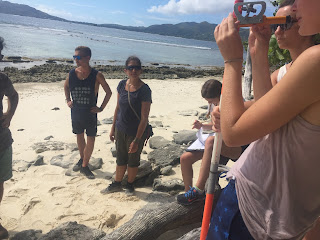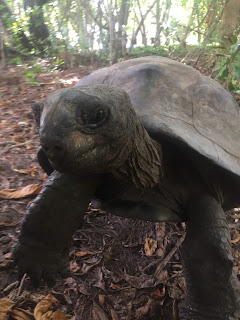Blog Week 6:
This week was
groundbreaking as well as
heartbreaking. Early in the day we set
out to go do about ten turtle nest excavations. Starting on the beach Anse
Jose, the first excavation we did was unsuccessful. When you find unhatched
eggs after the nest is empty, the eggs are opened and put into a category:
Undeveloped
Stage One
Stage Two
Predated
Predated beyond
recognition
Every single egg out
of the 167 laid in the nest were undeveloped. This nest had no bacteria or any
signs of outside influence on the eggs, they just never grew.
 After this nest, we
continued to find another whereas in the nest was another set of unhatched
eggs. In this of 171, we found six hatched eggs. The rest were stage three (an almost completely developed
hatching with a slight embryo remaining). This nest was buried deep under a
layer of what we thought at first were to be roots, but as we opened the eggs
we found that these white fiberous roots were actually a type of fungi that burrows through the shell of the eggs
and wraps itself around the turtle, restricting it from growing and causing it to die.
After this nest, we
continued to find another whereas in the nest was another set of unhatched
eggs. In this of 171, we found six hatched eggs. The rest were stage three (an almost completely developed
hatching with a slight embryo remaining). This nest was buried deep under a
layer of what we thought at first were to be roots, but as we opened the eggs
we found that these white fiberous roots were actually a type of fungi that burrows through the shell of the eggs
and wraps itself around the turtle, restricting it from growing and causing it to die. When we opened
these, however, all of them were stage one (where there is a visible
embryo the size of a grain of rice) but when a "healthy" egg is
opened, the entire content should be yellow whereas these eggs had a pink
bacteria growing in them. This bacteria
was found in a different nest a few weeks earlier and when none of the
specialists on the island could identify it, it was sent to a research lab in
Europe. The results are yet to be conclusive but the bacteria is thought to
have been feeding on the fluids inside the eggs, barely giving it the chance to
grow. This became a more current issue when six of the ten nests excavated that
day were found with unhatched eggs containing the same bacteria.
When we opened
these, however, all of them were stage one (where there is a visible
embryo the size of a grain of rice) but when a "healthy" egg is
opened, the entire content should be yellow whereas these eggs had a pink
bacteria growing in them. This bacteria
was found in a different nest a few weeks earlier and when none of the
specialists on the island could identify it, it was sent to a research lab in
Europe. The results are yet to be conclusive but the bacteria is thought to
have been feeding on the fluids inside the eggs, barely giving it the chance to
grow. This became a more current issue when six of the ten nests excavated that
day were found with unhatched eggs containing the same bacteria.
After these unsuccessful nests, the next days were spent in the mangroves. In this, we would rope off a 10x10 foot parameter where as inside you would count the number of mangroves, labeling them by species and by stage of life (juvenile, seedling, mature). This might seem like an easy task but when there are about 400 trees in the same area, it is easy to loose count.
Lastly, I got the chance to see the bioluminescent plankton that glow in the light during the night. Although I'm not studying them, the chance to seem them was exciting and it was beautiful.





































